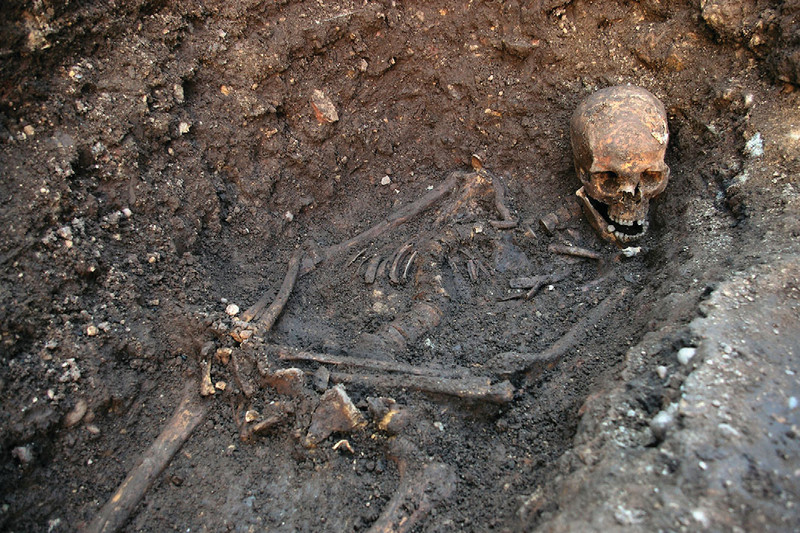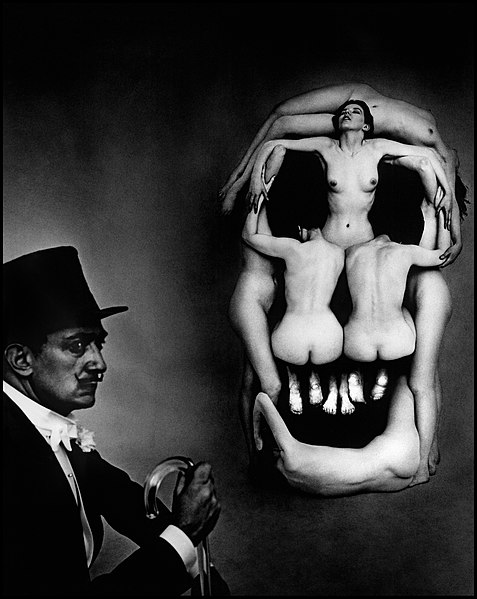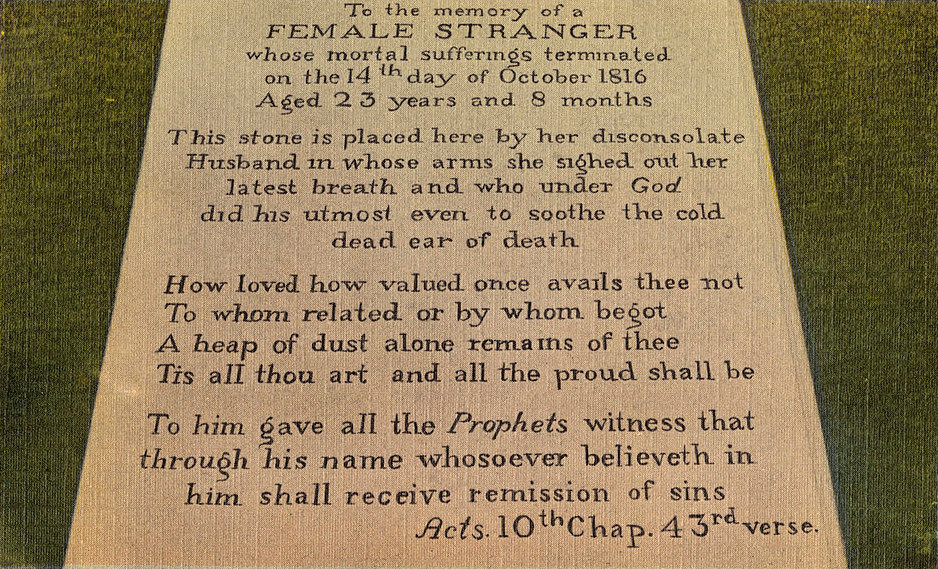Wha lies here? I Johnny Dow. Hoo! Johnny, is that you? Ay, man, but a'm dead now.
— Edinburgh epitaph, quoted in Horatio Edward Norfolk, Gleanings in Graveyards, 1861
Wha lies here? I Johnny Dow. Hoo! Johnny, is that you? Ay, man, but a'm dead now.
— Edinburgh epitaph, quoted in Horatio Edward Norfolk, Gleanings in Graveyards, 1861

The remains of Richard III were discovered under a Leicester car park in 2012. In the city center searchers located the site of the demolished Greyfriars Church where Richard’s body had been buried hastily in 1485, and the skeleton of an adult male human was found beneath the church’s choir. It exhibited severe scoliosis of the spine and 10 injuries to the head, rib, and pelvis, including “a mortal battlefield wound in the back of the skull” apparently inflicted by a halberd. The king’s identity was confirmed by a mitochondrial DNA sample provided by his modern descendants.
He was reburied in Leicester Cathedral in 2015.
04/13/2024 UPDATE: He was identified through descendants of his elder sister, Anne of York — he had no direct living descendants. My mistake. (Thanks, Steve.)

gliff
n. an unexpected view of something that startles one; a sudden fear
irrision
n. the act of sneering or laughing derisively; mockery; derision
mortiferous
adj. bringing or producing death
proceleusmatic
adj. inciting, animating, or inspiring
Photographer Philippe Halsman took three hours to pose seven women in the shape of a skull for his surrealistic portrait In Voluptas Mors, after a sketch by Salvador Dalí, who’s seen in the foreground. Director Jonathan Demme borrowed the idea for the one-sheet poster for his 1991 film The Silence of the Lambs — the skull image on the “death’s head moth” is a miniature version of the same tableau.

Diagnosed with terminal melanoma at 50, Phoebe Snetsinger resolved to devote her remaining time to watching birds. Between 1981 and 1999, as her cancer went periodically into remission, she visited every continent several times over, traversing jungles, swamps, deserts, and mountains and surviving malaria, a boat accident, abduction in Ethiopia, and rape in Papua New Guinea. In 1995 she became the first person to see 8,000 species of bird, and in time she extended the list to 8,398, nearly 85 percent of the world’s known species. She died in 1999 when her van overturned during a birding trip in Madagascar. The last bird she’d observed was a red-shouldered vanga, a species that had been described as new to science only two years previously.
In her memoir, Birding on Borrowed Time, she wrote, “When I was given my death sentence by the doctors, one of my immediate reactions that I clearly remember was ‘Oh no — there are all those things I haven’t yet done, and now will never have a chance to do.’ … The preparation and primarily the birding itself, plus the record keeping afterwards, all enabled me to forget the threat to my life (or at least push it aside) and to immerse myself totally in what I was doing.”

This enigmatic headstone stands in in St. Paul’s Cemetery in Alexandria, Virginia, over the body of an unknown woman. Nothing definite seems to be known as to the woman’s identity, apart from the year of her death, but the poignant epitaph has fueled speculation for more than two centuries. One common suggestion is that she was Theodosia Burr Alston, a daughter of Aaron Burr who disappeared at sea in 1813, but this doesn’t account for Alston’s whereabouts in the three years before the mystery woman’s interment at Alexandria. It seems unlikely now that the inscription will ever be explained.
Charles Guiteau, James Garfield’s assassin, read a poem at the gallows:
I am going to the Lordy, I am so glad. I am going to the Lordy, I am so glad. I am going to the Lordy, Glory hallelujah! Glory hallelujah! I am going to the Lordy!
I love the Lordy with all my soul, Glory hallelujah! And that is the reason I am going to the Lord. Glory hallelujah! Glory hallelujah! I am going to the Lord.
I saved my party and my land, Glory hallelujah! But they have murdered me for it, and that is the reason I am going to the Lordy. Glory hallelujah! Glory hallelujah! I am going to the Lordy!
I wonder what I will do when I get to the Lordy, I guess that I will weep no more when I get to the Lordy! Glory hallelujah!
I wonder what I will see when I get to the Lordy, I expect to see most splendid things, beyond all earthly conception, when I am with the Lordy! Glory hallelujah! Glory hallelujah! I am with the Lord.
He asked for an orchestral accompaniment, but it was denied.
11/18/2023 UPDATE: Improbably, Guiteau eventually got his accompaniment — in Stephen Sondheim’s 1990 musical Assassins, his character sings part of the poem while cakewalking up and down the scaffold:
(Thanks, Molly.)

1985 saw an oddity in the chess world: Russian grandmaster Viktor Korchnoi undertook a game with Hungarian Géza Maróczy, who had been dead for 34 years. The game was arranged by amateur Swiss player Wolfgang Eisenbeiss, who enlisted medium Robert Rollans to contact the deceased grandmaster and communicate his moves. (Rollans did not play chess and was not paid.)
Closely watched in Germany, the game took nearly eight years to unfold, hampered by Korchnoi’s schedule, Rollans’ illness, and Maróczy’s unhurried pace. Korchnoi, who won after 47 moves, remarked that his opponent had shown weakness in the opening but made up for it with a strong endgame.
After an analysis in 2007, neuropsychiatrist and amateur player Vernon Neppe declared that Maróczy had played at master level and that his moves could not have been found by a computer. Further, when asked to confirm his identity, the deceased grandmaster had dictated 38 pages of text to Rollans, complaining, “I am astonished when somebody does not believe me to be here personally.” Historian and chess expert Laszlo Sebestyen determined that 87.9 percent of Maróczy’s assertions there (about his playing, tournament wins, and personal life) had been accurate.
But in a 2021 critique, Edwin C. May and Sonali Bhatt Marwaha point out that Maróczy had typically taken 10 days to make each move, during which time Rollans might easily have consulted outside assistance. And the medium had had ample time to prepare Maróczy’s 1986 communication confirming his identity. Ultimately the answers lie with Rollans, who, ironically, passed quickly out of reach — he died just 19 days after Maróczy’s resignation.

On Aug. 20, 1961, Harvard physicist Percy Williams Bridgman was found dead at his home in the White Mountains of New Hampshire. After suffering for months with metastatic cancer, he had shot himself in the head. He left a two-sentence note:
“It isn’t decent for society to make a man do this thing himself. Probably this is the last day I will be able to do it myself. P.W.B.”
On June 17, 1794, Charles-Henri Sanson, high executioner of the First French Republic, guillotined more than 50 “conspirators” in 28 minutes, including an 18-year-old girl who seemed so fragile that “a tiger would have pitied her.” That night he wrote in his diary:
Terrible day. The guillotine devoured 54. My strength went, my heart failed me. That evening, sitting down to dinner, I told my wife that I could see spots of blood on my napkin. … I don’t lay claim to any sensibility I don’t possess: I have seen too often and too close up the sufferings and death of my fellow human beings to be easily affected. If what I feel is not pity it must be caused by an attack of nerves; perhaps it is the hand of God punishing my cowardly pliancy to what so little resembles that justice which I was born to serve.
(Quoted in Frances Larson, Severed, 2014.)
Entries in the keyword index of C. Bernard Ruffin’s Last Words (1995), a collection of the final utterances of famous people:
Minutes before his death, retired Supreme Court justice Felix Frankfurter told an aide visiting him in the hospital, “I hope I don’t spoil your Washington’s birthday.”